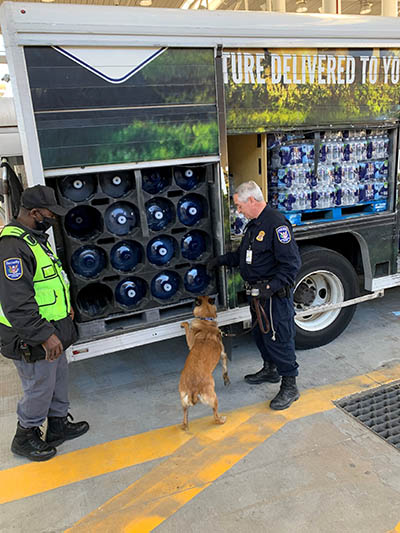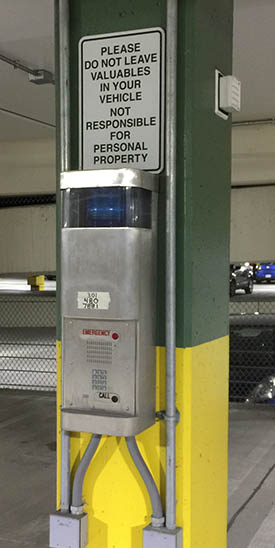News You Can Use: Safety
NIH Security and Emergency Response Office Ensures Everyone’s Safety
Before the COVID-19 pandemic, we had 27,000 people on NIH’s 300-acre campus in Bethesda, Maryland, each day. We are expecting a return to these levels at some point. This, coupled with the construction and potential hazards of offices left empty for so long, makes it important to review safety.
Entrusted with maintaining public safety on the scale of a small city is the Security and Emergency Response (SER) Office. SER, which falls under the umbrella of the Office of Research Services, is made up of six divisions: Police; Emergency Management, which includes a 911 emergency call center that operates round the clock; Fire and Rescue Services (DFRS), which provides fire, emergency medical, hazardous materials, and specialized rescue services; Fire Marshal, which ensures that buildings and offices are adhering to fire safety practices; Physical Security Management, which manages electronic security, surveillance systems, and locks and other physical deterrents; and Personnel Security and Access Control (DPSAC), which runs background investigations, issues badges, and operates the badge-controlled access system for offices, labs, and the NIH perimeter. DPSAC also operates badging facilities at several NIH properties to accommodate individuals working outside of the Bethesda campus. SER also coordinates a Counterintelligence and Insider Threat Program for the NIH.
Read on to learn more about Emergency Management, Police, and Fire and Rescue Services and when to contact them in the event of an emergency.
Emergency Communications Center (911 Call Center)
For any police, fire, or medical emergency at NIH-owned facilities, call the 911 Emergency Call Center, also known as the Emergency Communications Center (ECC). (See numbers at the end of this article.)
Division of Emergency Management
NIH’s Division of Emergency Management coordinates the response to large-scale incidents, such as the derecho (a damaging windstorm) that knocked out power to much of campus in June 2012. During these significant events, limiting 911 calls to concerns that require immediate fire or police action helps keep the lines open and ensures first responders are available when needed. After the 2011 earthquake, for example, staff indiscriminately pulled fire alarms while evacuating buildings and called 911 to ask for information. This caused a 15-minute wait on the emergency dispatch system and required fire department personnel to search all buildings where alarms had been pulled to be sure that no one was injured and to reset the alarms. Only pull a fire alarm if there is a fire.
How do you stay informed during an emergency? Sign up for AlertNIH, which will send emails or text notifications to announce emergencies and campus closures and to describe the nature of the situation and instructions on immediate actions. To receive alerts on your personal devices, you must provide accurate contact information for your entry in the NIH Enterprise Directory portal. Instructions for updating your record can be found here.
Division of Police
Approximately 90 NIH police officers serve the Bethesda campus, 12 protect Rocky Mountain Laboratories (RML in Hamilton, Montana), and six officers patrol the National Cancer Institute portion of the campus at Fort Detrick (Frederick, Maryland). Other off-campus facilities leased by NIH have their own federally-operated security services and formally coordinate security protocols with NIH’s Division of Physical Security Management. All NIH law enforcement officers train for a minimum of 480 hours at a certified federal training academy before they are authorized to carry a weapon and can respond to situations from routine traffic stops and criminal arrests up to a potential active shooter. In Bethesda, RML, and Fort Detrick, canine units assist with searching for explosives and firearms at campus entry points, respond to calls for suspicious packages, and conduct area sweeps before special events.
Officers attend more than 40 hours of annual in-service training to stay current on the latest law enforcement tactics as well as court cases and legislation relevant to policing operations. The department prides itself on staying in touch with the community and is involved with NIH’s UNITE initiative to end structural racism.

CREDIT: GERALD JORDAN, OD
An NIH policeman (right), a trained police dog, and a security guard inspect a commercial vehicle entering the NIH campus.
In addition to regular foot and vehicle patrols, NIH police conduct security screenings at patient, visitor, employee, and commercial vehicle entrance gates. Assisting officers at these checkpoints are NIH security guards, who are unarmed contractors who receive training with an emphasis on NIH security policy, procedures, and techniques.
Since the pandemic began, all nonpatient visitors are being asked whether they are visiting NIH in a business-related capacity. Depending on the COVID-19 community risk level, nonpatient visitors may be required to attest to their vaccination status; nonpatient visitors as well as employees who are not fully vaccinated or decline to report their status may need to show proof of a negative COVID-19 test within the past 72 hours to enter NIH property. Home test results are not accepted.
Officers also work with the NIH Clinical Center, the Children’s Inn, and the Safra Lodge to ensure the safety and comfort of patients, as well as respond to more than 350 incidents throughout campus in a typical year. Most are minor, such as a traffic violation or loud arguments. “We try to resolve issues with minimal police intervention and always on a positive note,” said Chief Security Officer William ”Bill” Cullen, who oversees all NIH security operations. “The [officer’s] job is to protect and serve, to be a guardian, not an enforcer.”
If you witness a crime, discover a suspicious object, feel threatened, or fear for your safety, immediately call the appropriate emergency number. And always report suspicious activity—such as unrecognized individuals wandering through offices or repeatedly looking up at security cameras—to the NIH police at its nonemergency number. (See list at end of this article.)

CREDIT: JAMES “KENT” CHANDLER, OD
More than 100 blue light phones, located on walkways and in parking garages, can be used to call for emergency assistance.
Distributed throughout the Bethesda campus walkways and parking structures are 105 blue light phones (BLP), with most units featuring a closely mounted blue light for easy identification. For immediate emergency assistance, each BLP will dial the ECC automatically after a person presses the call button. Some BLPs are also equipped with a strobe feature that activates when the call button is depressed.
Police help with nonemergency requests, too, such as unlocking offices or labs for employees who have lost or misplaced their keys. They also provide escorts for anyone who feels unsafe walking across campus at any hour. A supervisor can request police presence if an employee is being given a letter of reprimand or termination.
As more cars and pedestrians return to campus amid new construction projects, traffic safety will be a top priority. Note that moving violations committed on NIH property are cited under state law and will result in points applied to your driver’s license. “It’s been a long time since we’ve seen a lot of traffic on campus,” said Cullen. “I really want people to have their head on a swivel when they come back.” Motorists and pedestrians alike need to remain alert and obey all traffic rules. In addition, pedestrians should always use crosswalks and motorists should always yield to pedestrians in crosswalks.
Division of Fire and Rescue Services
NIH’s DFRS personnel are on call for 72-hour shifts in which they live and sleep at the NIH firehouse. The 30 firefighters include those trained from the entry-level firefighter up to the more advanced fire officer. These first responders administer emergency medical services, perform rescues, and mitigate fires, floods, and hazardous material (hazmat) spills.
Stuck in an elevator? Press the alarm button and use the emergency phone to alert the fire department.
If you have a medical emergency, you’re in good hands. More than half of the department’s calls are medically related. If additional medical care or advanced life support is needed, a pair of ambulances are standing by to transport patients to Suburban Hospital down the street.

You might even spot an NIH ladder truck or hazmat vehicle out in the community because the department has a mutual aid agreement with Montgomery County and Walter Reed National Military Medical Center. “Our fire department is probably the best in the [Capitol region] and perhaps the East Coast in responding to hazmat,” said Cullen. The fire and rescue team have advanced training and sophisticated testing equipment to identify and safely mitigate toxic chemical spills in a lab, as well as biohazardous and radioactive materials.

CREDIT: MAT CHIBBARO, OD
In a recent training exercise at the NIH Clinical Center, firefighters in NIH’s Division of Fire and Rescue Service practiced snaking a fire hose through a nursing unit.
The DFRS conducts its own in-service training. A recent exercise in the NIH Clinical Center involved a simulation in which a fire hose had to be snaked through a nursing unit where many people were hurt, and firefighters had to navigate through people moving around and blocking an access stairwell. DFRS also participates in quarterly Montgomery County Fire Department–led battalion trainings, which allow for real-life scenarios to be actively trained on and promotes vital coordination with the surrounding community.
In addition to fires and hazardous material spills, all strange or burning odors should be immediately reported to the fire department. You should never assume someone else has reported it or the that source of the odor is nonhazardous. To report, call the appropriate emergency number. (See list at end of this article.)
Being safety savvy is everyone’s responsibility. The foundation of NIH’s multilayered security lies with its police and fire and rescue first responders. “Their dedication to the NIH is based on what they can do to enhance public safety and serve the community,” said Cullen. “And they do it 24/7.”
Emergency and non-emergency numbers and websites
- For fire, police, and medical emergencies (from land lines): 911 (Bethesda campus), 9-911 (other NIH facilities); 0 (Rocky Mountain Laboratories).
- For fire, police, and medical emergencies (from cell phones): 301-496-9911 (Bethesda campus); 911 (other NIH facilities).
- For nonemergency police requests and to report a criminal act not in progress, a theft of personal property, or a non-injury accident: 301-496-5685 (Bethesda); 311 (Baltimore); 301-619-7114 (Fort Detrick); 406-363-2100 (Rocky Mountain Labs).
Websites for more information:
- Emergency Communications Center: https://ors.od.nih.gov/ser/dp/Pages/911-Call-Center.aspx
- Division of Police (includes safety tips and education videos): https://ors.od.nih.gov/ser/dp/Pages/default.aspx
- Division of Emergency Management: https://ors.od.nih.gov/ser/dem/Pages/default.aspx
- Division of the Fire Marshal: https://ors.od.nih.gov/ser/dfm/Pages/default.aspx
- Division of Fire and Rescue Services: https://ors.od.nih.gov/ser/dfrs/Pages/default.aspx
- Division of Physical Security Management: https://ors.od.nih.gov/ser/dpsm/Pages/default.aspx
- Division of Personnel Security and Access Control: https://ors.od.nih.gov/ser/dpsac/Pages/Home.aspx
This page was last updated on Thursday, June 30, 2022
